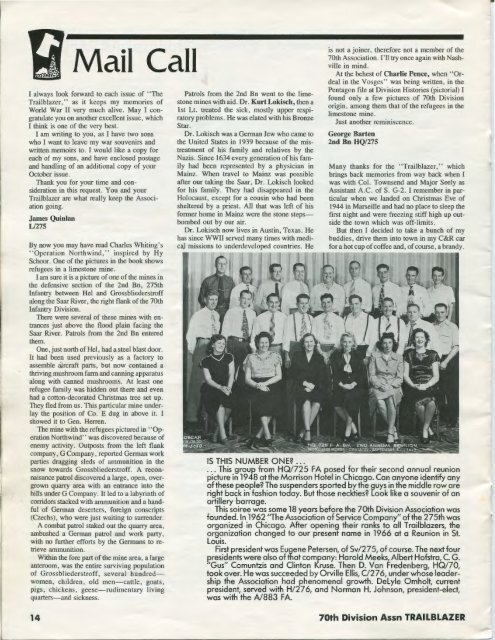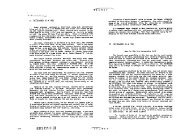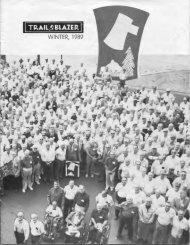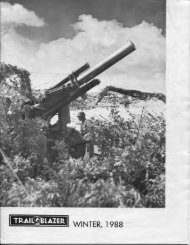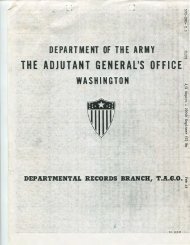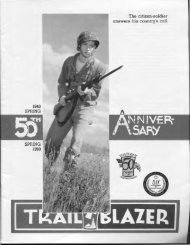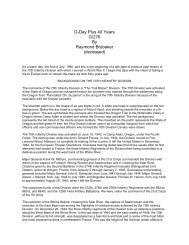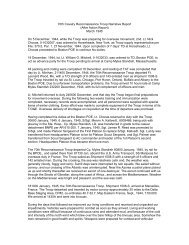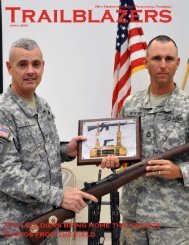Spring, 1987 - 70th Infantry Division Association
Spring, 1987 - 70th Infantry Division Association
Spring, 1987 - 70th Infantry Division Association
- No tags were found...
You also want an ePaper? Increase the reach of your titles
YUMPU automatically turns print PDFs into web optimized ePapers that Google loves.
Mail Call<br />
I always look forward to each issue of "The<br />
Trailblazer," as it keeps my memories of<br />
World War II very much alive. May I congratulate<br />
you on another excellent issue, which<br />
I think is one of the very best.<br />
I am writing to you, as I have two sons<br />
who I want to leave my war souvenirs and<br />
written memoirs to. I would like a copy for<br />
each of my sons, and have enclosed postage<br />
and handling of an additional copy of your<br />
October issue.<br />
Thank you for your time and consideration<br />
in this request. You and your<br />
Trailblazer are what really keep the <strong>Association</strong><br />
going.<br />
J ames Quinlan<br />
L/275<br />
By now you may have read Charles Whiting's<br />
"Operation North wind," inspired by Hy<br />
Schoor. One of the pictures in the book shows<br />
refugees in a limestone mine.<br />
I am sure it is a picture of one of the mines in<br />
the defensive section of the 2nd Bn, 275th<br />
<strong>Infantry</strong> between He! and Grossbliederstroff<br />
along the Saar River, the right flank of the <strong>70th</strong><br />
<strong>Infantry</strong> <strong>Division</strong>.<br />
There were several of these mines with entrances<br />
just above the flood plain faci ng the<br />
Saar River. Patrols from the 2nd Bn entered<br />
them.<br />
One, just north of Hel, had a steel blast door.<br />
It had been used previously as a factory to<br />
assemble aircraft parts, but now contained a<br />
thriving mushroom farm and canning apparatus<br />
along with canned mushrooms. At least one<br />
refugee family was hidden out there and even<br />
had a cotton-decorated Christmas tree set up.<br />
They fled from us. This particular mine underlay<br />
the position of Co. E dug in above it. I<br />
showed it to Gen. Herren.<br />
The mine with the refugees pictured in "Operation<br />
Northwind" was discovered because of<br />
enemy activity. Outposts from the left flank<br />
company, G Company, reported German work<br />
parties dragging sleds of ammunition in the<br />
snow towards Grossbliederstroff. A reconnaisance<br />
patrol discovered a large, open, overgrown<br />
quarry area with an entrance into the<br />
hills under G Company. It led to a labyrinth of<br />
corridors stacked with ammunition and a handful<br />
of German deserters, foreign conscripts<br />
(Czechs), who were just waiting to surrender.<br />
A combat patrol staked out the quarry area,<br />
ambushed a German patrol and work party,<br />
with no further efforts by the Germans to retrieve<br />
ammunition.<br />
Within the fore part of the mine area, a large<br />
anteroom, was the entire surviving population<br />
of Grossbliederstroff, several hundredwomen,<br />
children, old men-cattle, goats,<br />
pigs, chickens, geese-rudimentary living<br />
quarters-and sickness.<br />
Patrols from the 2nd Bn went to the limestone<br />
mines with aid. Dr. Kurt Lokisch, then a<br />
1st Lt. treated the sick, mostly upper respiratory<br />
problems. He was elated with his Bronze<br />
Star.<br />
Dr. Lokisch was a German Jew who came to<br />
the United States in 1939 because of the mistreatment<br />
of his family and relatives by the<br />
Nazis. Since 1634 every generation of his family<br />
had been represented by a physician in<br />
Mainz. When travel to Mainz was possible<br />
after our taking the Saar, Dr. Lokisch looked<br />
for his family. They had disappeared in the<br />
Holocaust, except for a cousin who had been<br />
sheltered by a priest. All that was left of his<br />
former home in Mainz were the stone stepsbombed<br />
out by our air.<br />
Dr. Lokisch now lives in Austin, Texas. He<br />
has since WWII served many times with medica.!<br />
missions to underdeveloped countries. He<br />
is not a joiner, therefore not a member of the<br />
<strong>70th</strong> <strong>Association</strong>. I'll try once again with Nashville<br />
in mind.<br />
At the behest of Charlie Pence, when " Ordeal<br />
in the Vosges" was being written, in the<br />
Pentagon fi le at <strong>Division</strong> Histories (pictorial) I<br />
found only a few pictures of <strong>70th</strong> <strong>Division</strong><br />
origin, among them that of the refugees in the<br />
limestone mine.<br />
Just another reminiscence.<br />
George Barten<br />
2nd Bn HQ/275<br />
Many thanks for the "Trailblazer," which<br />
brings back memories from way back when I<br />
was with Col. Townsend and Major Seely as<br />
Assistant A.C. of S. G-2. I remember in particular<br />
when we landed on Christmas Eve of<br />
1944 in Marseille and had no place to sleep the<br />
first night and were freezi ng stiff high up outside<br />
the town which was off-limits.<br />
But then I decided to take a bunch of my<br />
buddies, drive them into town in my C&R car<br />
for a hot cup of coffee and, of course, a brandy.<br />
IS THIS NUMBER ONE . . .<br />
. . . This group from HQ/725 FA posed for their second annual reunion<br />
picture in 1948 at the Morrison Hotel in Chicago. Can anyone identify any<br />
of these people The suspenders sported by the guys in the middle row are<br />
right back in fashion today. But those neckties Look like a souvenir of an<br />
artillery barrage.<br />
This soiree was some 18 years before the <strong>70th</strong> <strong>Division</strong> <strong>Association</strong> was<br />
founded. In 1962 "The <strong>Association</strong> of Service Company" of the 275th was<br />
organized in Chicago. After opening their ranks to all Trailblazers, the<br />
organization changed to our present name in 1966 at a Reunion in St.<br />
Louis.<br />
First president was Eugene Petersen, of Sv/275, of course. The next four<br />
wesidents were also of that company: Harold Meeks, A lbert Hofstra, C. G.<br />
'Gus" Comuntzis and Clinton Kruse. Then D. Van Fredenberg, HQ/70,<br />
took over. He was succeeded by Orville Ellis, C/27 6, under whose leadership<br />
the <strong>Association</strong> had phenomenal growth. DeLyle Omholt, current<br />
president, served with H/27 6, and Norman H. Johnson, president-elect,<br />
was with the A/883 FA.<br />
14<br />
<strong>70th</strong> <strong>Division</strong> Assn TRAILBLAZER


